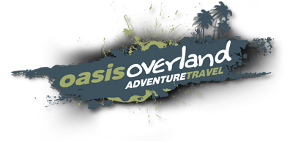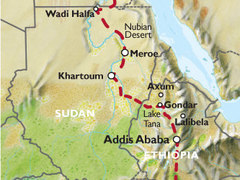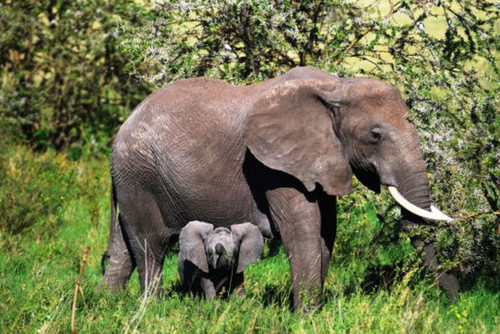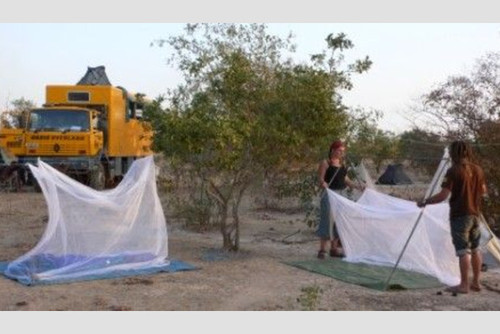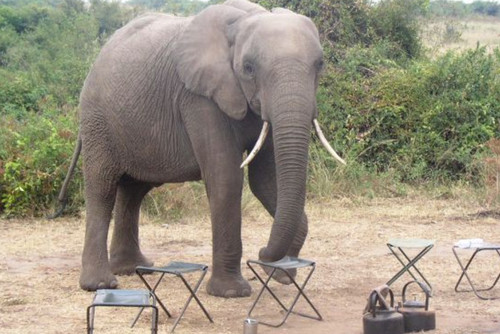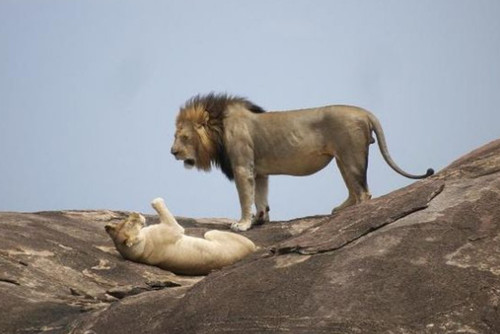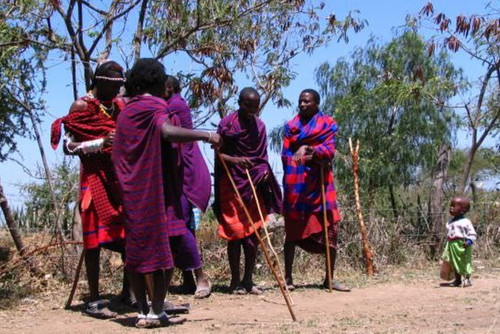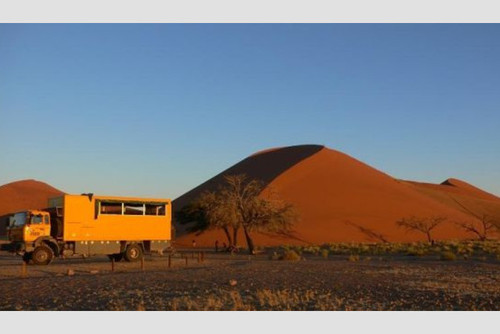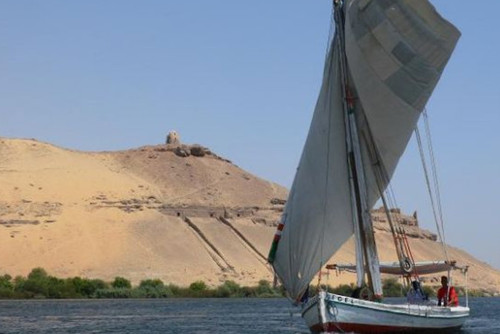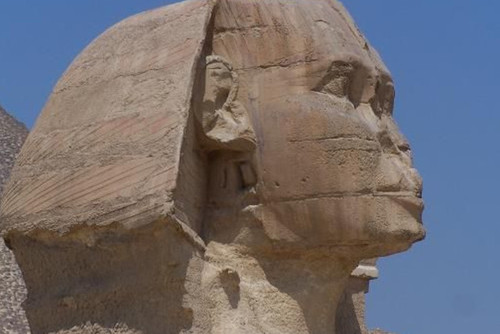From crossing deserts, rivers and mountains and overcoming a multitude of challenges this continent can throw at you, inter-twined with stunning National Parks, some of the best adventure activity play grounds in the world, this is a trip that will linger in the memory long after you finish.
Itinerary
Days 1 to 8
Our trip continues from Nairobi and heads north into one of Africa's greatest natural features, the East African Rift Valley. Stretching from the Dead Sea in Jordan down to Mozambique in Southern Africa, our first view is from the top of a steep escarpment. Overland trips through East Africa will allow you to experience some of the most dramatic scenery in the world, and the Rift Valley is a definite highlight. The valley floor seems to sweep on forever and is dotted with volcanic peaks, shimmering lakes and countless springs. Our journey takes us into the heart of the Rift Valley to Lake Naivasha. We camp near the lakeshore where Hippos sometimes feed at night! Here you can walk to Elsamere, the house of Joy Adamson - of Elsa the Lion and Born Free fame, and enjoy a film of her life - and cream teas! You can also hire mountain bikes and cycle or walk through Hells Gate National Park - the only game reserve in Kenya in which you are permitted to do so.Or for a less active but equally enjoyable game viewing experience - visit the Crater Lake Game Sanctuary. Both offer excellent scenery & opportunities to spot hyrax, abundant bird & plant life along with several types of gazelle, impala and eland.
A further half day drive through hills covered in tea plantations and rural scenery drive brings us to Lake Nakuru National Park - home to a wide variety of wildlife including Black Rhino, Hippo, Lion, Leopard, Hyena and Giraffe. However, Nakuru is a soda lake and most famous for its pink inhabitants, a flock of almost a million Pink Flamingos which feed noisily along the shoreline. A mountainous drive with spectacular scenery through the Nandi Hills brings us to our next stop at Eldoret. From here we cross into Uganda, and continue west to the capital. Kampala has had a turbulent past, but these days it is a friendly and safe city. We have a free day to spend in local cafes and nightspots - where you can get to know the local people. There is also the opportunity to spend the day visiting a local Chimpanzee Sanctuary and rehabilitation centre on one of the islands on Lake Victoria.
Days 9 to 15
The following day we have a long drive as we head west through swamps, patches of forest and fertile green countryside. As we travel through Uganda, we'll pass through a number of small towns and villages; Mpigi, where you will see roadside stalls manufacturing and selling traditional musical instruments; Kyazanga, where we can buy fresh rotisserie and roasted meat and vegetables, as well as roasted plantain bananas. We will also be able to make a photo stop where our route crosses the Equator.
The Virunga range of volcanic mountains and the rainforests on these mountain slopes are home to several families of Highland Mountain Gorillas. Getting up close to these amazing creatures is a truly a once in a lifetime experience and one of the highlights of the trip. You have the opportunity to trek to see the Gorillas in Rwanda (bookable as an Add on). It is estimated that only around 700 of these gentle giants remain. This mountainous area on the borders of Rwanda, Uganda and Zaire (now renamed Democratic Republic of Congo) is their only natural habitat and they are periodically threatened by poachers and political instability in the area. One permit allows you to spend about 50 to 60 minutes with one of the gorilla families. Trekking to find them in groups of 8 people can take anywhere from half an hour to 5 hours. The organisations and well-trained guides that continually monitor and protect the families are conscientious and responsible. There will also be an opportunity to visit the genocide memorial in Kigali, which is a moving and humbling experience
We then return towards Kampala and camp near Jinja - Uganda's adventure playground. Here, on the edge of Lake Victoria, the Nile begins its 6700km journey to the sea. We spend the next few days downstream from the source of the Nile. This is a spectacular area, and a superb place to go whitewater rafting or kayaking. You can also organise quad biking , horse riding or a visit to a local education project.
Days 16 to 26
Re-entering Kenya, we travel around the foothills of Mount Kenya before embarking on the next phase of our journey. This leads us into the remoteness of northern Kenya - where we will encounter some of the worst roads on the entire trip. Nomadic tribes people like the Rendille in Marsabit & the Samburu (cousins of the Maasai) still wear very distinctive and often elaborate dress.
As we cross into Ethiopia - many of the roads we travel on are very poor dirt or gravel roads and often in mountainous areas, so travel is slow. Ethiopia has a lot more visual & indigenous history than any other sub - Saharan country. We continue our journey north heading into the Omo Valley. This little visited region is home to some of the most colourful ethnic groups in Ethiopia. The friendly Hamar people are noted for their ornate, interesting hairstyles and the Mursi people are famous for the clay lip plates and earlobe decorations. An optional 2 day tour will take you into the Omo National Park.
Days 27 to 33
We spend a couple of days in the capital Addis Ababa where we have the chance to indulge in some authentic Ethiopian coffee or explore 'El Mercato' - one of East Africa's largest open air markets. We also spend the next few days organizing our Sudanese and Egyptian visas - before heading onto Bahir Dar via the spectacular Blue Nile Gorge & Falls. Based on the southern edge of Lake Tana - you can organise boat trips to some of the small islands which have Monasteries dating back up to 900 years, and which are still looked after by monks who live from subsistence farming.
Days 34 to 41
In the towns of Bahir Dar and Gondar (the capital of Ethiopia from 1632 until 1868), we spend about 4 days at each - where it is possible to organise visits to some of Ethiopia's most famous sites, including the holy city of Axum and the rock-hewn churches at Lalibela. These date from the 12th Century and have been kept alive by generations of dedicated priests who guard their precious religious and artistic artifacts. The border with Sudan is not far from Gondar and the first towns after the border are Gedaref & Wadi Medani.
Days 42 to 48
The hospitality in Sudan can be surprising - but very genuine. For such a poor country with so many recent problems - Sudanese people are often too willing to invite you for a meal or a cup of 'Sudanese whisky' - better known as tea! Khartoum is our next stop and it has a fantastic setting on the confluence of the Blue and White Niles. Our stay here is on the banks of the Nile at the quirky but interesting Blue Nile Sailing Club. It houses one of General Kitcheners old Gunboats, a relic from the British military campaign against the Mahdi over a century ago. For such a large city, Khartoum feels quite laid back. Here you can visit the Hamed al Nil Tomb or take a trip to the daily camel market or viewing the confluence of the two Niles are also an interesting ways to pass the time.
The ancient Pyramids at Meroe lie to the north of the capital Khartoum. Our drive across the Nubian Desert will see us either hugging the banks of Nile as it snakes its way north or possibly experiencing the vast open desert plains which is dissected by the main train line from Khartoum - making this our only real point of reference. Whether passing through sleepy Nubian villages ,resting in tea rooms, pottering around the local souqs or experiencing total isolation in the middle of the desert - a unique experience awaits you along this not so travelled route to Wadi Halfa.
Days 49 to 55
Upon reaching Lake Nasser and the port of Wadi Halfa in Northern Sudan, we board the ferry to Egypt - our ultimate destination on our expedition. The ferry takes about a day and a night and is a supremely relaxing way to travel, and a great opportunity to mix and chat to local Egyptian and Sudanese people alike. We rejoin our expedition vehicle which has travelled on a separate barge and make our way to Aswan. Here you will notice you will notice one of the many cultural changes on this trip - the darker Nubian people in Aswan lead a more relaxed and less hectic pace of life than their Egyptian countrymen. We base ourselves here for the next 3 or 4 days to finalise in which time you can join a 2 or 3 day felucca boat cruise to Edfu and Kom Ombo. The opportunity to visit Abu Simbel - the massive stone monuments built by the greatest of all pharaohs, Ramses ll, is always a highlight before continuing to Luxor.
Days 56 to 61
You will be kept busy exploring in Luxor - where we visit the Valley of Kings and Queens. Here, the remarkably well preserved tombs of the ancient rulers -namely Ramses ll and Tutankhamun -have coloured paintings and hieroglyphics that still seem fresh even after 3000 years. Karnak and Luxor Temples are both in easy walking distance from our camp - as is the local souq where you can pick up the last of your souvenirs. The following day we drive out towards the Red Sea Coast. You will have time relax on the beach for a couple of days or try your hand at various watersports such as snorkelling, windsurfing or scuba diving in the cool clear blue waters. Our final destination, Cairo is only a few hours away. Visiting the great Pyramids and Sphinx at Giza with our Egyptologist guide and also the Egyptian Natural History Museum in the afternoon is definitely a fitting way to end this amazing expedition.
Tour Price
Trip Price: £1450.00 + Local Payment: US$775.00
Oasis Overland Reviews
There are no reviews, click 'Add a review' to submit one
Have you booked : Nairobi to Cairo (9 weeks) Nile Trans? Please share your experience and submit your review.

